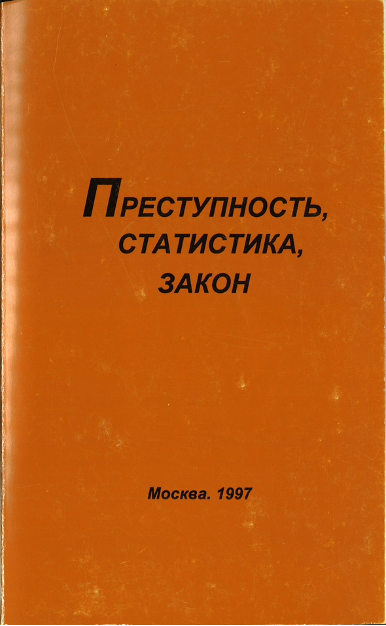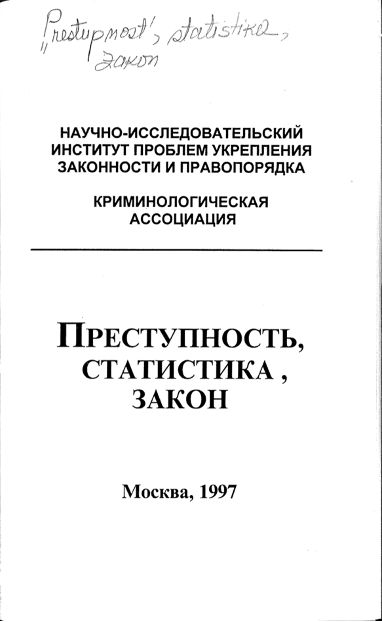Filed Under: Print > Journalism > Russian Crime Statistics, 1980-1996
Russian Crime Statistics, 1980-1996
[2 items]
In the late 1980s and early 1990s, crime in the Soviet Union and Russia skyrocketed. Between 1989 and 1992, most registered offenses grew by 20–25% each year. But something surprising happened beginning in 1994: crime went down. By most measures, society had not stabilized. Pyramid schemes, for instance, peaked that year with the meteoric rise and fall of MMM. The shelling of the White House was less than a year in the past, and the first Chechen War (1994-1995) was underway. Yet the trend continued, with lower numbers of crimes reported, fewer criminals convicted, and fewer victims found.
Meanwhile, Russia finally adopted its first post-Soviet criminal code. For the first five years of the Russian Federation, law enforcement had functioned under the Criminal Code of the Russian Soviet Federated Socialist Republic, although this document had undergone some changes. “Crimes against socialist property,” for instance, had been on the books until January 1994, and accounted for 642,595 crimes in 1993, or 23% of the total registered crimes that year. Although such definitional changes may account for some of the statistical drop, law enforcement saw lower numbers not just in total crime, but also within each individual category.
To better understand this issue and to track crime rates through the lifetime of the Soviet-era criminal code, a group of sociologists and criminologists under the leadership of Azalia Dolgova combed through the available data and published Crime, Statistics, Law (1997) just after the new criminal code was passed. The results of the study are striking. They show not only a steep increase in crime during the years of transition from communism, but also a leveling-off in the mid-1990s. Narratives of the time do not usually register this plateau in crime. Perhaps this is because crime was still staggeringly widespread. For instance, although 1995 recorded almost 7,000 fewer aggravated assaults than did 1994 (67,706 in 1994 vs. 61,734 in 1995), the number was still more than triple what it was in 1988 (20,100). Crime, in other words, was not under control in the mid-1990s, instead reaching a saturation point. And while Dolgova’s study stops in 1996, the absolute numbers show in stark statistical detail the havoc that governmental collapse, the market economy, and societal upheavals had wreaked on the lives of ordinary Russians.
Meanwhile, Russia finally adopted its first post-Soviet criminal code. For the first five years of the Russian Federation, law enforcement had functioned under the Criminal Code of the Russian Soviet Federated Socialist Republic, although this document had undergone some changes. “Crimes against socialist property,” for instance, had been on the books until January 1994, and accounted for 642,595 crimes in 1993, or 23% of the total registered crimes that year. Although such definitional changes may account for some of the statistical drop, law enforcement saw lower numbers not just in total crime, but also within each individual category.
To better understand this issue and to track crime rates through the lifetime of the Soviet-era criminal code, a group of sociologists and criminologists under the leadership of Azalia Dolgova combed through the available data and published Crime, Statistics, Law (1997) just after the new criminal code was passed. The results of the study are striking. They show not only a steep increase in crime during the years of transition from communism, but also a leveling-off in the mid-1990s. Narratives of the time do not usually register this plateau in crime. Perhaps this is because crime was still staggeringly widespread. For instance, although 1995 recorded almost 7,000 fewer aggravated assaults than did 1994 (67,706 in 1994 vs. 61,734 in 1995), the number was still more than triple what it was in 1988 (20,100). Crime, in other words, was not under control in the mid-1990s, instead reaching a saturation point. And while Dolgova’s study stops in 1996, the absolute numbers show in stark statistical detail the havoc that governmental collapse, the market economy, and societal upheavals had wreaked on the lives of ordinary Russians.

